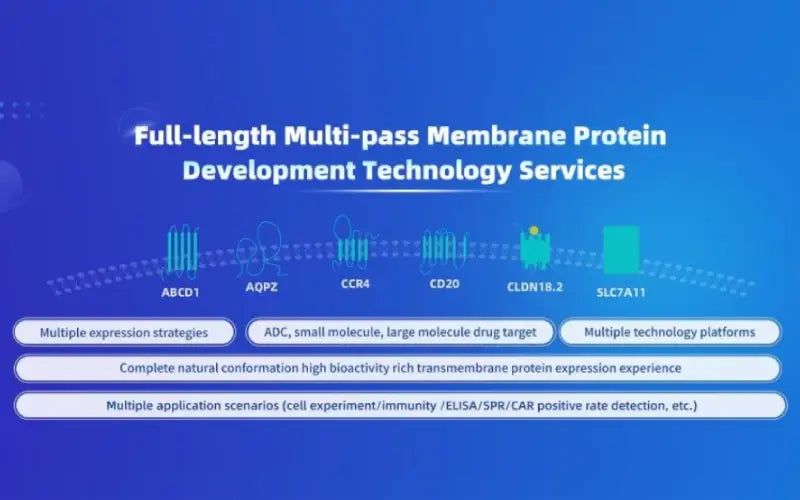Full-length Multi-transmembrane Protein Development Technology Service

Technology platform: Detergents and Nanodiscs

Detergents technology : Detergents can destroy the phospholipid bilayer and help transmembrane proteins to be gently released from the membrane environment while maintaining their natural conformation and activity. By finely regulating the type and concentration of detergents, damage to transmembrane proteins can be effectively reduced, laying a solid foundation for subsequent structural analysis and functional research.
Advantages:
- Has a natural and complete conformation
- Accurate quantification
- Can be applied to immunity/ELISA/SPR/BLI/protein crystal structure analysis, etc.

Nanodiscs technology : uses artificially synthesized nanoscale structures to provide a cell membrane-like microenvironment for transmembrane proteins. The core is membrane scaffold proteins (MSPs), which together with phospholipid molecules form a phospholipid bilayer-like membrane structure. This structure allows membrane proteins to be integrated into Nanodiscs to maintain their biological activity. It has been widely used in many famous scientific research institutions and pharmaceutical companies around the world, promoting research in membrane protein-related fields.
Advantages:
- The full-length transmembrane protein is in a near-natural membrane environment and maintains biological activity
- High stability
- Good water solubility
- No detergent is required in subsequent experiments and it can be directly used for cytological analysis
- Can be used for protein crystal structure analysis, electron microscopy (EM)/immunity/ELISA/SPR/BLI/CAR positive rate detection, etc.
Receptor proteins: Transmembrane proteins receive external signals and transmit them to the interior of the cell, triggering intracellular signal cascade reactions. For example, G-protein coupled receptors (GPCRs) are involved in signal transduction.

Ion channels: allow specific ions to pass through the cell membrane, such as sodium channels (Na⁺channels).

Transporters: Transmembrane proteins act as channels or carriers to help ions, nutrients, and waste products cross the cell membrane. For example, the sodium-potassium pump (Na⁺/K⁺-ATPase) and glucose transporters (GLUT) are responsible for the transport of substances.

Aquaporins: Aquaporins facilitate the transport of water along an osmotic gradient across biological membranes. AQPs usually exist as tetramers in cell membranes, with each monomer containing a single pore that allows water to pass through. The movement of water and solutes through AQP channels is a passive process that depends on the concentration of the molecules being transported.





